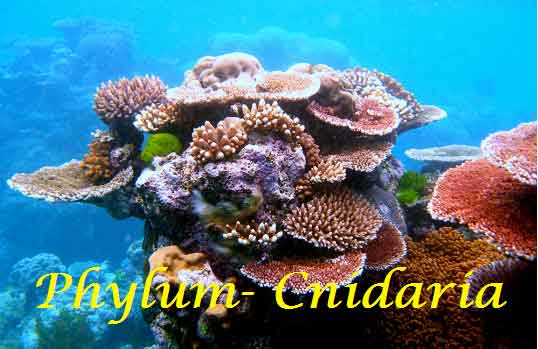Leuckart (1847) first coined the name Cnidaria. The term ‘Cnidaria’ is derived from two words; Gr. Knide=nettle and L. aria=like or connected with. Cnideraia are also known as Coelenterata. They have diverse colorful, radially symmetrical bodies which are known as the flower of the sea. The phylum Cnidaria contains more than 10,000 living species, among them, mostly are marine animals whereas only 20 species inhabit in freshwater. The notable cnidarians include hydras, the corals, Portuguese men-of-war, jellyfish, sea anemones, sea whips, sea pens, and sea fans. Their variety, diverse colorful symmetry body forms, and complex life histories attract the scientists. They are diversely and abundantly distributed in tropical waters. They have calcareous skeletons which form the framework of the reefs and atolls in most tropical seas. The famous reef is the Great Barrier Reef which is more than 2000 km along the northeastern coast of Australia, made by the cnidarians.
General Characteristics Of Phylum Cnidaria
- They are aquatic organisms, mostly are marine and few inhabit in freshwater.
- They are diploblastic animals with a radially symmetrical body.
- The body wall consists of outer ectoderm and, inner endoderm or gastrodermis. In between the two layers, a non-cellular mesoglea is present.
- The body bears one central body cavity or gastrovascular cavity is known as coelenterons which gives the alternative name, Coelenterata.
- The representatives of cnidarians can make microscopic intracellular stinging capsules, known as nematocysts or cnidae, which also give the phylum name ‘Cnidaria’.
- The ectodermal layer contains different types of cells like endothelio-muscle cells, interstitial cells, glandulo-muscle cells, cnidoblasts or nematocysts, sensory cells, germ cells, and nerve cells.
- Endoderm or gastrodermis contains five types of cells such as endothelio-muscle cells or nutritive cells, interstitial cells, endothelio-gland cells, nerve cells, and sensory cells.
- The interstitial cells have totipotent functions because they have the capability to produce any other cells like reproductive, glandular, specialized stinging cells, called cnidoblasts which secrete hypnotoxin (poison).
- They have incomplete alimentary canal because the anal opening is absent whereas the gut cavity contains a single opening which is known as mouth. In this case, mouth serves for ingestion and egestion.
- They are carnivorous and can digest all types of food. In this case, digestion is unique with extracellular digestion followed by intracellular digestion.
- They have a short and slender body with tentacles which encircle the mouth in one or two whorls. In this case, tentacles function for food-engulfing, capturing the prey and defense.
- In nature, they have two distinct forms such as polyp and medusa (Polymorphism). In this case, polyps are sessile (asexual stage) while medusa is free-swimming (sexual stage).
- In their body, circulatory, respiratory and excretory systems are absent. Through general body surface, gaseous exchange and excretion occur.
- They can move with the help of smooth muscle fibrils in the epithelia or ectoderm. Tentacles also play a vital role in the movement.
- The nervous system is poorly developed which makes the network of nerve fibers in the body walls and the tentacles.
- The body bears single or complicated sensory organs with eyespots called statocysts.
- They reproduce either asexual by external budding or sexual by the formation of ova and sperm.
- They show alternation of generation (metagenesis) in their life cycle, in which asexual colonial polypoid generation alternate with sexual free-swimming medusoid generation.
- Fertilization is internal or external and development is indirect with a larval stage. In this case, planula larva is a common but ephyra larva is found in some animals.
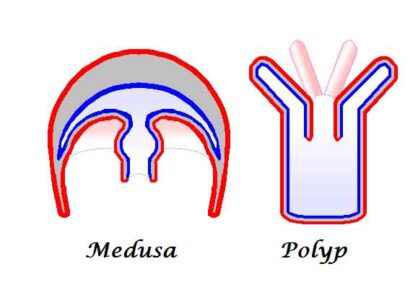
Image showing medusa and polyp forms
Classification of Phylum Cnidaria/Coelenterata
The phylum Cnidaria is composed of the following three classes on the basis of development of zooids:
- Hydrozoa (hydrozoans);
- Scyphozoa (scyphozoans);
- Anthozoa (anthozoans);
Class-1: Hydrozoa (Hydra; water; zoon: animal)
- They are mostly marine organisms but some inhabit freshwater.
- Some species inhabit solitary and some form colony.
- They are diploblastic animals. Between two layers, mesoglea is present which is simple and acellular.
- The gonads are ectodermal in origin.
- They show asexual polyp stage and sexual medusa stage in their life cycle. In this case, the polyp stage is the dominant and medusa possesses true velum.
- The body contains statocysts to maintain equilibrium.
Examples:Hydra oligactis, Obelia bidentata, Physalia physalis (portuguese man of war) etc.
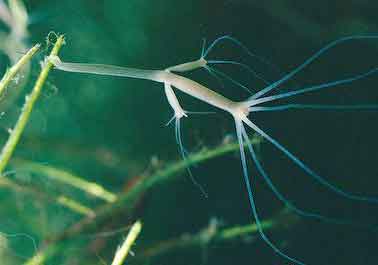
Hydra oligactis
You might also read: Phylum Annelida: General Characteristics and Its Classification
Class 2: Scyphozoa
- This class includes about 200 described species..
- The body length of the most jellies range from 2 to 40 cm but the largest scyphozoan species (Cyanea capillata) can reach up to two meters in diameter.
- They are completely marine organisms.
- They are free-swimming and are solitary.
- Thick jelly-like cellular mesoglea is present.
- Polyp stage is undeveloped or absent.
- Bell or umbrella-shaped medusa is present.
- Medusa stage is prominent and it does not have velum.
- To maintain equilibrium, they have tentaculocytes.
- In their life cycle, the larval stage is present (Ephyra larva).
- Gonads are originated from endoderm.
Example:Aurelia aurita (Jelly fish), Rhizostoma pulmo etc.

Aurelia aurita (Jelly fish)
Class-3: Anthozoa (Anthos: flower; zoios: animal ‘flower-like animals’)
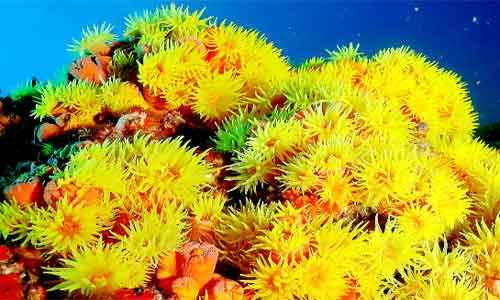
Anthozoa Colony
- The class Anthozoa contains about 6100 described species.
- They have cylindrical–shaped body and are attached directly to a submerged substrate.
- They are completely marine organisms.
- They inhabit to form a colony and some are solitary.
- Cellular mesoglea region is present which consists of fibrous connective tissue and amoeboid cells.
- In their life cycle, only the polyp stage is present.
- Gonads are originated from endoderm. In tropical seas, they form reefs by secreting calcium carbonate (CaCO3).
- They give rise to a free-swimming planula larva in their life cycle.
Example:Gorgonia ventalina (the purple sea fan), Pennatula phosphorea (common Sea Pen), Metridium parvulum (sea anemone), etc
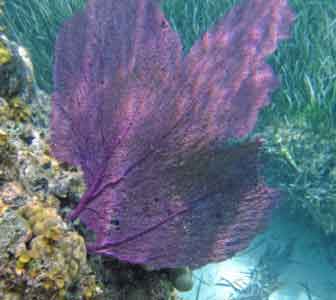
Gorgonia ventalina
Concluding Remarks
The representatives of Phylum Cnidaria have radial or biradial symmetrical body. About 99 % cnidarians are marine species and few inhabit in freshwater. They are diploblastic animals and have a more complex level of organization than Porifera. In their body wall, outer ectoderm, inner endoderm layers are present but in between these two layers non-cellular mesoglea is found. In their life cycle, they show two distinct morphological forms such as polypoid and medusoid.

